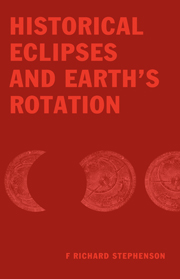Book contents
- Frontmatter
- Contents
- Principal Symbols
- 1 Variations in the length of the day: a historical perspective
- 2 Tidal friction and the ephemerides of the Sun and Moon
- 3 Pre-telescopic eclipse observations and their analysis
- 4 Babylonian and Assyrian records of eclipses
- 5 Investigation of Babylonian observations of solar eclipses
- 6 Timed Babylonian lunar eclipses
- 7 Untimed Babylonian observations of lunar eclipses: horizon phenomena
- 8 Chinese and other East Asian observations of large solar eclipses
- 9 Other East Asian observations of solar and lunar eclipses
- 10 Records of eclipses in ancient European history
- 11 Eclipse records from medieval Europe
- 12 Solar and lunar eclipses recorded in medieval Arab chronicles
- 13 Observations of eclipses by medieval Arab astronomers
- 14 Determination of changes in the length of the day
- Appendix A Timed data
- Appendix B Untimed data
- References
- Acknowledgements
- Index of eclipse records
- Index of places of observation
- Name Index
- Subject index
7 - Untimed Babylonian observations of lunar eclipses: horizon phenomena
Published online by Cambridge University Press: 13 November 2009
- Frontmatter
- Contents
- Principal Symbols
- 1 Variations in the length of the day: a historical perspective
- 2 Tidal friction and the ephemerides of the Sun and Moon
- 3 Pre-telescopic eclipse observations and their analysis
- 4 Babylonian and Assyrian records of eclipses
- 5 Investigation of Babylonian observations of solar eclipses
- 6 Timed Babylonian lunar eclipses
- 7 Untimed Babylonian observations of lunar eclipses: horizon phenomena
- 8 Chinese and other East Asian observations of large solar eclipses
- 9 Other East Asian observations of solar and lunar eclipses
- 10 Records of eclipses in ancient European history
- 11 Eclipse records from medieval Europe
- 12 Solar and lunar eclipses recorded in medieval Arab chronicles
- 13 Observations of eclipses by medieval Arab astronomers
- 14 Determination of changes in the length of the day
- Appendix A Timed data
- Appendix B Untimed data
- References
- Acknowledgements
- Index of eclipse records
- Index of places of observation
- Name Index
- Subject index
Summary
Introduction
In the previous chapter, a variety of Babylonian timings of lunar eclipse contacts were analysed. Several of these records also noted that the Moon rose (ki E-a) or set (SU) whilst eclipsed. Additionally, some damaged texts do not contain useful measurements of time but nevertheless affirm that the Moon was eclipsed at its rising or setting. Such fairly straightforward observations (which enable limits on the value of ΔT to be deduced), would require no instrumental aid. In the following pages these various observations will be investigated together with a few rather more careful reports which give an estimate of the fraction of the Moon covered at moonrise or moonset.
Since the eclipsed Moon is in direct opposition to the Sun, it invariably rises close to sunset or sets near sunrise. It thus usually reaches the horizon when the sky is quite bright – often when the Sun is above the opposite horizon. However, as noted in chapter 4, despite these seemingly unfavourable conditions the Babylonians systematically measured the time of moonrise (relative to sunset) and moonset (in relation to sunrise) around full Moon with considerable care. Many examples of this practice are found in one of the earliest surviving astronomical diaries – dating from 568 BC, the 37th year of Nebuchadrezzar II (see SH I, pp. 47 ff.) – and it may extend back much further in time.
- Type
- Chapter
- Information
- Historical Eclipses and Earth's Rotation , pp. 193 - 212Publisher: Cambridge University PressPrint publication year: 1997



